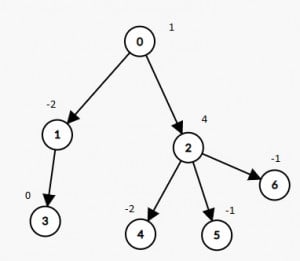Using Depth First Search Algorithm to Delete Tree Nodes with Sum
- 时间:2020-09-10 13:27:27
- 分类:网络文摘
- 阅读:115 次
A tree rooted at node 0 is given as follows:
The number of nodes is nodes;
The value of the i-th node is value[i];
The parent of the i-th node is parent[i].
Remove every subtree whose sum of values of nodes is zero.After doing so, return the number of nodes remaining in the tree.
Input: nodes = 7, parent = [-1,0,0,1,2,2,2], value = [1,-2,4,0,-2,-1,-1]
Output: 2binary-tree-delete-nodes-with-zero-sum-sub-tree
Constraints:
1 <= nodes <= 10^4
-10^5 <= value[i] <= 10^5
parent.length == nodes
parent[0] == -1 which indicates that 0 is the root.Hints:
Traverse the tree using depth first search.
Find for every node the sum of values of its sub-tree.
Traverse the tree again from the root and return once you reach a node with zero sum of values in its sub-tree.
How to Delete Nodes from Binary Tree using Depth First Search Algorithm?
The binary tree is given in two arrays, we can convert it using the adjacent graph – two dimension array or vectors. Then we can run a DFS (Depth First Search) algorithm that travels the tree from root to leaves recursively.
Bottom-up, from the leaves, we accumulate the sum and the count of the nodes (remaining). At any point, if the sum is zero, we set the counter to zero – which will be bubbled up as the recursion unrolls.
1 2 3 4 5 6 7 8 9 10 11 12 13 14 15 16 17 18 19 20 21 22 23 | class Solution { public: int deleteTreeNodes(int nodes, vector<int>& parent, vector<int>& value) { vector<vector<int>> g(nodes, vector<int>(0)); for (int i = 0; i < nodes; ++ i) { if (parent[i] == -1) continue; g[parent[i]].push_back(i); } return dfs(g, 0, value)[1]; } private: vector<int> dfs(const vector<vector<int>> &g, int root, const vector<int>& value) { int sum = value[root]; int remain = 1; for (const auto &child: g[root]) { vector<int> r = dfs(g, child, value); remain += r[1]; sum += r[0]; } if (sum == 0) remain = 0; return {sum, remain}; } }; |
class Solution {
public:
int deleteTreeNodes(int nodes, vector<int>& parent, vector<int>& value) {
vector<vector<int>> g(nodes, vector<int>(0));
for (int i = 0; i < nodes; ++ i) {
if (parent[i] == -1) continue;
g[parent[i]].push_back(i);
}
return dfs(g, 0, value)[1];
}
private:
vector<int> dfs(const vector<vector<int>> &g, int root, const vector<int>& value) {
int sum = value[root];
int remain = 1;
for (const auto &child: g[root]) {
vector<int> r = dfs(g, child, value);
remain += r[1];
sum += r[0];
}
if (sum == 0) remain = 0;
return {sum, remain};
}
};The time complexity is O(N) where N is the number of the nodes in the binary tree. The space complexity is also O(N) due to the stack in recursion.
–EOF (The Ultimate Computing & Technology Blog) —
推荐阅读:The Review of cozmo robot from Anki Scaling Digital Marketing Agencies Through White Label Solutions How to Solve the Lemonade Change Problem by Simulation Algorithm How to Sum within A Range in a Binary Search Tree? Magik Says Happy Valentines by Drawing a Heart to Console Cloud-Ready Infrastructure Optimization Freedom of Speech Isn’t So Free 10 Things You Should Do When Starting an Online Store The Importance of Cybersecurity in Real Life The Best Productivity Trends and Hacks of 2015
- 评论列表
-
- 添加评论
